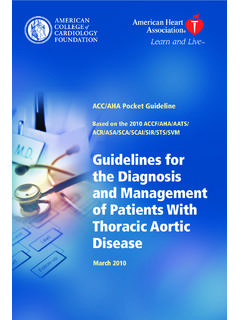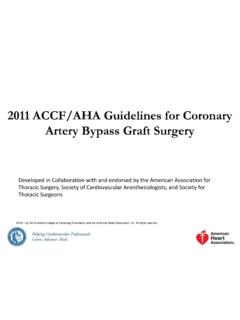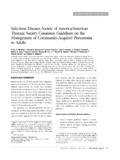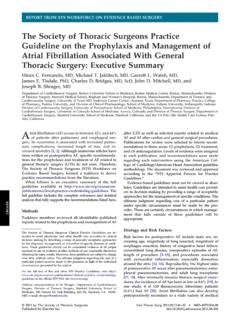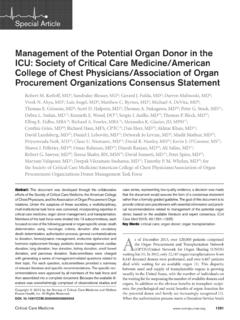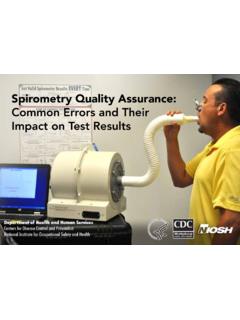Transcription of 2014 AHA/ACC Guideline for the Management of …
1 2014 AHA/ACC Guideline for the Management of Patients With ValvularHeart DiseaseDeveloped in Collaboration with the american Association for thoracic Surgery, american Society of Echocardiography, Society for Cardiovascular Angiography and Interventions, Society of Cardiovascular Anesthesiologists, and Society of thoracic Surgeons american College of Cardiology Foundation and american Heart AssociationCitationThis slide set is adapted from the 2014 AHA/ACC Guideline for the Management of Patients With ValvularHeart Disease (Journal of the american College of Cardiology).Published on March 3, 2014, available at: full-text guidelines are also available on the following Web sites:ACC ( ) and AHA ( )Robert O.
2 Bonow, MD, MACC, FAHA Carlos E. Ruiz, MD, PhD, FACC Blase A. Carabello, MD, FACC* Nikolaos J. Skubas, MD, FASE John P. Erwin III, MD, FACC, FAHA Paul Sorajja, MD, FACC, FAHA#Robert A. Guyton, MD, FACC* ThoralfM. Sundt III, MD* ** Patrick T. O Gara, MD, FACC, FAHA James D. Thomas, MD, FASE, FACC, FAHA Slide Set EditorsRick A. Nishimura and Catherine M. OttoValvularHeart Disease GuidelineWriting Committee MembersRick A. Nishimura, MD, MACC, FAHA, Co-Chair Catherine M. Otto, MD, FACC, FAHA, Co-Chair *Writing committee members are required to recuse themselves from voting on sections to which their specific relationships with industry and other entities may apply.
3 ACC/AHA representative. ACC/AHA Task Force on Performance Measures liaison. ACC/AHA Task Force on Practice Guidelines liaison. SCA Representative. #SCAI Representative. **AATS Representative. STS Representative. ASE Representative. Classification of Recommendations and Levels of EvidenceA recommendation with Level of Evidence B or C does not imply that the recommendation is weak. Many important clinical questions addressed in the guidelines do not lend themselves to clinical trials. Although randomized trials are unavailable, there may be a very clear clinical consensus that a particular test or therapy is useful or effective.
4 *Data available from clinical trials or registries about the usefulness/ efficacy in different subpopulations, such as sex, age, history of diabetes mellitus, history of prior myocardial infarction, history of heart failure, and prior aspirin use. For comparative-effectiveness recommendations (Class I and IIa; Level of Evidence A and B only), studies that support the use of comparator verbs should involve direct comparisons of the treatments or strategies being of Progression of VHDS tageDefinitionDescriptionAAt riskPatients with risk factors for the development of VHD BProgressive Patients with progressive VHD (mild-to-moderate severity and asymptomatic)CAsymptomatic severe Asymptomatic patients who have reached the criteria for severe VHDC1: Asymptomatic patients with severe VHD in whom the left or right ventricle remains compensatedC2.
5 Asymptomatic patients who have severe VHD, with decompensation of the left or right ventricleDSymptomatic severe Patients who have developed symptoms as a result of VHDD iagnostic Testing Diagnosis and Follow-UpRecommendationsCORLOETTE is recommended in the initial evaluation of patients with known or suspected VHD to confirm the diagnosis, establish etiology, determine severity, assess hemodynamic consequences, determine prognosis, and evaluate for timing of interventionIBTTE is recommended in patients with known VHD with any change in symptoms or physical examination findingsICPeriodic monitoring with TTE is recommended in asymptomatic patients with known VHD at intervals depending on valve lesion, severity, ventricular size.
6 And ventricular functionICDiagnostic Testing Diagnosis and Follow-UpRecommendationsCORLOEC ardiac catheterization for hemodynamic assessment is recommended in symptomatic patients when noninvasive tests are inconclusive or when there is a discrepancy between the findings on noninvasive testing and physical examination regarding severity of the valve lesionICExercise testing is reasonable in selected patients with asymptomatic severe VHD to 1) confirm the absence of symptoms, or 2) assess the hemodynamic response to exercise, or 3) determine prognosisIIaBFrequency of Echocardiograms in Asymptomatic Patients With VHD and Normal Left Ventricular Function StageValve LesionStageAortic StenosisAortic RegurgitationMitral StenosisMitral RegurgitationProgressive (stage B)Every 3 5 y (mild severity m/s)Every 1 2 y (moderate severity m/s)Every 3-5 y (mild severity)Every 1-2 y (moderate severity)Every 3 5 y(MVA > cm2)Every 3 5 y (mild severity)Every 1 2 y (moderate severity)Severe (stage C)Every 1 y (Vmax 4 m/s)Every 1 y Dilating LV more frequent Every 1 2 y (MVA cm2)Every 1 y (MVA <1 cm2)
7 Every 6 months to 1 yDilating LV more frequentBasic Principles of Medical TherapyRecommendationsCORLOES econdary prevention of rheumatic fever is indicated in patients with rheumatic heart disease, specifically mitral stenosisICProphylaxis against infective endocarditis (IE) is reasonable for the following patients at highest risk for adverse outcomes from IE prior to dental procedures that involve manipulation of gingival tissue, manipulation of the periapicalregion of teeth, or perforation of the oral mucosa: Patients with prosthetic cardiac valves; Patients with previous IE; Cardiac transplant recipients with valve regurgitation due to a structurally abnormal valve; or(continued on next page)IIaBBasic Principles of Medical TherapyRecommendationsCORLOE(continued) Patients with CHD with:oUnrepaired cyanotic CHD, including palliative shunts and conduits;oCompletely repaired congenital heart defect repaired with prosthetic material or device, whether placed by surgery or by catheter intervention, during the first 6 months after the procedure.
8 OroRepaired CHD with residual defects at the site or adjacent to the site of a prosthetic patch or prosthetic device IIaBProphylaxis against IE is not recommended in patients with VHD at risk of IE for nondentalprocedures ( , TEE, esophagogastroduodenoscopy, colonoscopy, or cystoscopy) in the absence of active infectionIII: No BenefitBLow Risk (must meet ALL criteria in this column )Intermediate Risk (any 1 criteria in this column)High Risk (any 1 criteria in this column)Prohibitive Risk(any 1 criteria in this column) STS PROM<4%AND 4% to 8%OR>8%ORPredicted risk with surgery of death or major morbidity (all-cause) >50% at 1 y ORFrailtyNoneAND1 index (mild)OR2 or more indices (moderate-to-severe)
9 ORMajor organ system compromise not to be improved postoperativelyNoneAND1 organ system ORNo more than 2 organ systems OR3 or more organ systems OR Procedure-specific impedimentNonePossible procedure-specific impedimentPossible procedure-specific impedimentSevere procedure-specific impedimentRisk Assessment Combining STS Risk Estimate, Frailty, Major Organ System Dysfunction, and Procedure-Specific ImpedimentsThe Heart Valve Team and Heart Valve Centers of ExcellenceRecommendationsCORLOEP atients with severe VHD should be evaluated by a multidisciplinary Heart Valve Team when intervention is consideredICConsultation with or referral to a Heart Valve Center of Excellence is reasonable when discussing treatment options for 1) asymptomatic patients with severe VHD, 2) patients who may benefit from valve repair versus valve replacement, or 3)
10 Patients with multiple comorbidities for whom valve intervention is consideredIIaCStages of ValvularAortic StenosisStageDefinitionValve AnatomyValve HemodynamicsHemodynamic ConsequencesSymptomsAAt risk of AS Bicuspid aortic valve (or other congenital valve anomaly) Aortic valve sclerosis Aortic Vmax<2 m/s None NoneBProgressive AS Mild-to-moderate leaflet calcification of a bicuspid or trileaflet valve with some reduction in systolic motion or Rheumatic valve changes with commissural fusion Mild AS: Aortic m/s or mean P <20 mm Hg Moderate AS: Aortic m/s or mean P 20 39 mm Hg Early LV diastolic dysfunction may be present Normal LVEF NoneStagesof ValvularAortic StenosisStageDefinitionValve AnatomyValve HemodynamicsHemodynamic ConsequencesSymptomsC -Asymptomatic severe AS C1 Asymptomatic severe AS Severe leaflet calcification or congenital stenosis with severely reduced leaflet opening Aortic Vmax 4 m/s or mean P 40 mm Hg AVA typically is 1 cm2(or AVAi cm2/m2)
